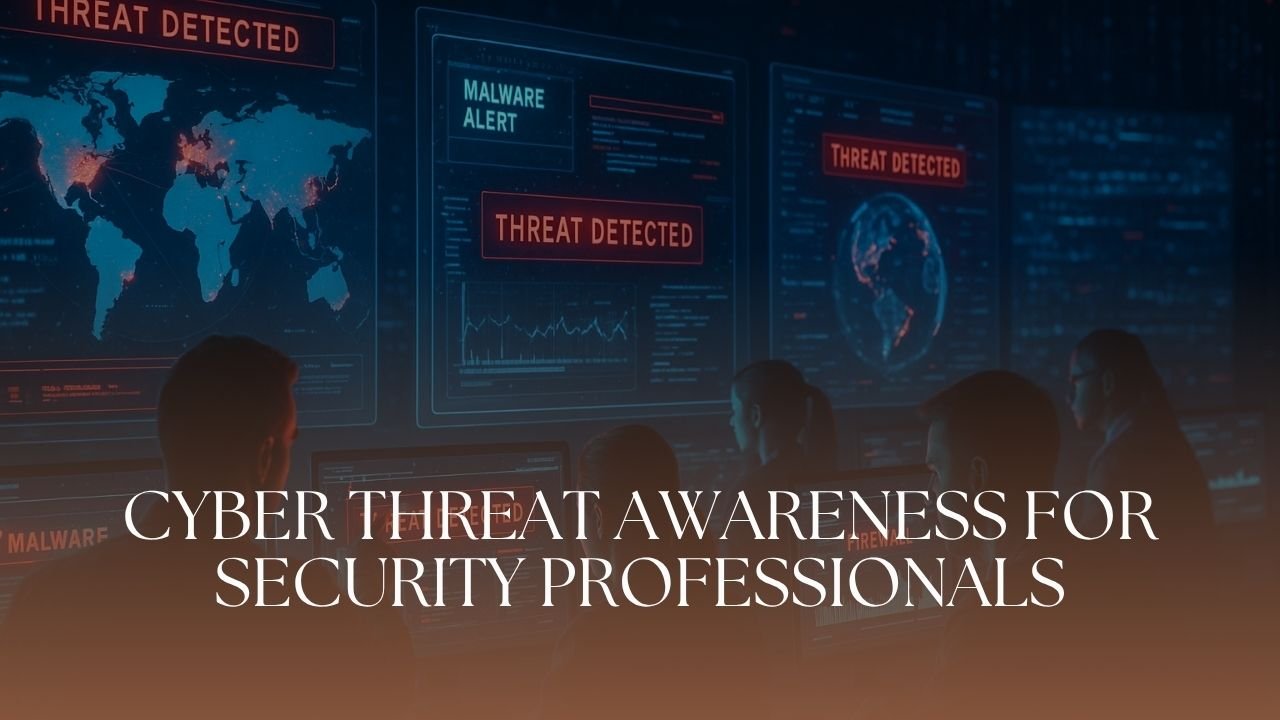Cyber Threat Awareness: The world of cybersecurity is changing faster than ever. Every year, new digital threats emerge, targeting businesses, governments, and individuals alike. For security professionals, staying aware of these threats is not just important — it’s essential.
Cyber attacks are becoming smarter, more organized, and increasingly automated. One successful breach can lead to millions in losses, damaged reputations, and compromised national or corporate security.
This article offers a complete roadmap for professionals who want to strengthen their cyber threat awareness. You’ll learn about the latest attack trends, common vulnerabilities, awareness program structures, incident-response strategies, and best practices to stay ahead of cyber criminals.
Understanding Cyber Threat Awareness
Cyber threat awareness means recognizing the types of threats that exist, how they operate, and what signs indicate potential compromise. It’s about building a culture where security professionals can identify, report, and respond to risks before they turn into crises.
Awareness is the first line of defense. Without it, even the most advanced technologies cannot protect an organization. In today’s connected world, awareness bridges the gap between human judgment and digital defense.
Why Cyber Threat Awareness Is Crucial for Security Professionals
Cybersecurity professionals are the backbone of digital protection systems. They manage firewalls, monitor networks, and respond to incidents. Yet, even they can fall victim to sophisticated phishing campaigns, insider threats, or AI-driven social engineering.
The reasons awareness matters:
- Human error remains the top cause of security breaches, accounting for more than 80% of incidents globally.
- Attackers exploit behavior patterns, not just system flaws.
- Early detection through awareness reduces recovery costs significantly.
In short, awareness equals preparedness. The better informed you are, the faster you can identify unusual activity and act decisively.
The Evolving Cyber Threat Landscape
The threat environment is constantly shifting. Modern attacks are not just about stealing data — they’re about disrupting operations, manipulating information, and breaching critical infrastructure.
Key Threat Trends (2025 and Beyond)
- AI-Driven Phishing: Attackers use AI tools to generate personalized phishing emails that appear indistinguishable from real communications.
- Ransomware Evolution: Modern ransomware doesn’t just lock data — it steals it first, then threatens public exposure.
- Supply-Chain Attacks: Hackers target third-party software vendors to compromise multiple organizations at once.
- IoT and Smart Device Exploits: As connected devices multiply, attackers exploit weak firmware or unsecured endpoints.
- Insider Threats: Employees or contractors with access can cause serious harm, intentionally or accidentally.
- Nation-State Cyber Warfare: Countries use cyber tools for espionage, sabotage, and disruption of foreign infrastructure.
Each of these trends increases the importance of a continuous, updated awareness program for professionals in the field.
Common Types of Cyber Threats
To combat threats effectively, professionals must first recognize their forms. Below is a detailed overview of the main categories and what they involve.
| Threat Type | Description | Typical Targets | Indicators of Compromise |
|---|---|---|---|
| Phishing | Fake emails or messages trick users into sharing credentials or clicking links. | Employees, executives, finance teams | Suspicious links, spelling errors, urgency cues |
| Ransomware | Malware encrypts files and demands payment for access restoration. | Hospitals, SMEs, government systems | Locked files, ransom notes, high CPU usage |
| DDoS Attacks | Overloads servers to make services unavailable. | E-commerce sites, gaming, finance | Unusual network traffic, downtime |
| Insider Threats | Employees misuse access or accidentally leak data. | Corporations, agencies | Unauthorized access logs, large data transfers |
| Zero-Day Exploits | Attackers exploit unknown software vulnerabilities. | Critical infrastructure, software providers | Crashes, unusual processes, unpatched systems |
| Social Engineering | Psychological manipulation to gain information or access. | Anyone with system privileges | Fake authority claims, urgent requests |
| IoT Device Exploits | Weak smart devices used as entry points. | Factories, hospitals, homes | Unauthorized device connections, irregular traffic |
Core Components of Cyber Threat Awareness Programs
An effective cyber threat awareness program should include structured components that ensure continuous learning, proactive defense, and adaptive responses.
1. Training and Education
Security professionals must receive role-specific training that mirrors real-world scenarios. Interactive workshops, phishing simulations, and red-team exercises improve detection and response skills.
2. Continuous Monitoring
Awareness isn’t a one-time effort. Continuous monitoring of logs, alerts, and network anomalies is essential. Advanced tools like SIEM (Security Information and Event Management) systems can enhance this process.
3. Policy Development
Clear policies help maintain consistency. Examples include:
- Password management and authentication standards
- Data access restrictions
- Device and endpoint security guidelines
- Reporting procedures for suspicious activity
4. Threat Intelligence Sharing
Security professionals should exchange information with peers, industry groups, and trusted networks to stay aware of evolving threats.
5. Incident Response Integration
An awareness program should align with incident response plans. Professionals must know what to do immediately when a breach or suspicious activity occurs.
Frameworks and Models for Cyber Awareness
NIST Cybersecurity Framework (Simplified Overview)
Even without direct references, most professional programs align with five main phases of cyber defense:
- Identify – Understand assets, systems, and risks.
- Protect – Implement safeguards to prevent attacks.
- Detect – Continuously monitor to identify anomalies.
- Respond – Take action once a threat is confirmed.
- Recover – Restore normal operations and improve resilience.
This model encourages both proactive and reactive defense, ensuring awareness leads to measurable results.
Building a Culture of Awareness in Security Teams
Culture determines success. Even with advanced technology, poor communication or complacency can undermine security.
Key Steps to Build Awareness Culture:
- Conduct weekly threat briefings for your team.
- Use internal newsletters highlighting new threats and prevention tips.
- Reward employees for reporting suspicious activity.
- Encourage open dialogue without fear of blame.
A culture that values awareness ensures that every team member acts as an extension of the organization’s defense network.
Real-World Examples of Cyber Threat Awareness in Action
Example 1: Phishing Response Training
A healthcare organization conducted simulated phishing campaigns every month. Over six months, the rate of employees clicking fake links dropped from 28% to just 3%.
Example 2: Insider Threat Mitigation
A financial firm noticed unusual data exports from a mid-level manager’s account. Because the staff had been trained to report anomalies, the issue was caught early, preventing a major leak.
Example 3: IoT Security Program
A manufacturing company secured its connected machinery after awareness sessions revealed that default passwords were still active on factory IoT devices.
Tools That Enhance Cyber Threat Awareness
While awareness is primarily human-driven, technology plays a vital supporting role.
Key Tools:
- SIEM Solutions: Aggregate logs and detect anomalies.
- Endpoint Detection & Response (EDR): Protect individual devices.
- Threat-Intelligence Platforms: Provide data on global attack trends.
- User Behavior Analytics (UBA): Identify irregular user actions.
- Email Security Gateways: Filter phishing attempts.
When professionals use these tools with a deep understanding of threats, awareness becomes actionable intelligence.
Measuring the Effectiveness of Awareness Programs
Without measurement, improvement is impossible. Below are quantitative and qualitative metrics security professionals can track.
| Metric | Purpose | Frequency |
|---|---|---|
| Training completion rate | Measures participation and compliance. | Quarterly |
| Phishing simulation success rate | Tracks awareness and vigilance. | Monthly |
| Incident response time | Evaluates detection and mitigation efficiency. | Continuous |
| Policy adherence score | Ensures guidelines are being followed. | Bi-annually |
| Employee feedback surveys | Gathers perceptions of training relevance. | After each session |
These metrics provide tangible proof that awareness efforts are paying off.
Overcoming Common Challenges
Even experienced professionals face hurdles when implementing awareness programs.
1. Alert Fatigue
Too many system alerts can overwhelm teams. Prioritize alerts by severity and automate filtering for false positives.
2. Rapidly Evolving Threats
Cyber criminals adapt quickly. Schedule monthly threat briefings and review defensive measures regularly.
3. Limited Resources
Smaller teams can focus on high-impact controls: patch management, access control, and multi-factor authentication.
4. Communication Gaps
Bridging technical and non-technical teams is crucial. Use plain language when explaining risks to executives and stakeholders.
5. Overconfidence in Technology
Even the best software cannot replace human awareness. Continuous education is the only sustainable defense.
Practical Tips for Security Professionals
- Always verify the sender before clicking links or opening attachments.
- Use complex, unique passwords with multi-factor authentication.
- Back up critical data regularly.
- Keep software and firmware updated.
- Segment networks to isolate critical systems.
- Report any unusual network activity immediately.
- Encourage cross-team collaboration — IT, HR, and Legal all play roles.
- Simulate attacks to test preparedness in real scenarios.
The Future of Cyber Threat Awareness
The next generation of cyber threats will be shaped by artificial intelligence, quantum computing, and autonomous attack tools. This evolution will demand adaptive awareness strategies.
Future programs will include:
- AI-driven threat detection integrated into awareness dashboards.
- Gamified training modules to make learning engaging.
- Continuous skill certification for professionals.
- Real-time simulation environments to mimic modern attack vectors.
As cybercrime becomes more automated, human awareness will remain the strongest line of defense.
Cyber threat awareness is not an option — it’s an ongoing commitment to vigilance, adaptability, and professional excellence. For security professionals, this awareness determines how effectively they can protect systems, data, and people.
In a digital world filled with deception and evolving risks, awareness means power. It empowers professionals to anticipate rather than react, to secure rather than repair, and to lead rather than follow.
By combining structured programs, smart tools, and continuous education, you can build a resilient defense posture that thrives in the face of uncertainty.
Staying aware today ensures a safer, smarter tomorrow.
FAQs
What is the main goal of cyber threat awareness?
The goal is to help professionals recognize, understand, and respond to threats proactively, reducing the risk of data breaches and downtime.
How often should cyber threat awareness training be updated?
At least once every six months, with additional refreshers after any major system change or new threat trend.
What’s the difference between awareness and training?
Awareness focuses on understanding and recognizing threats, while training involves practical skills and actions for responding effectively.




